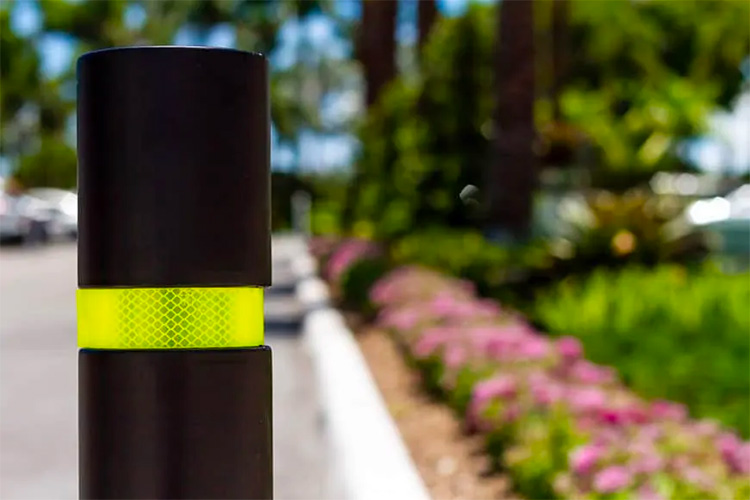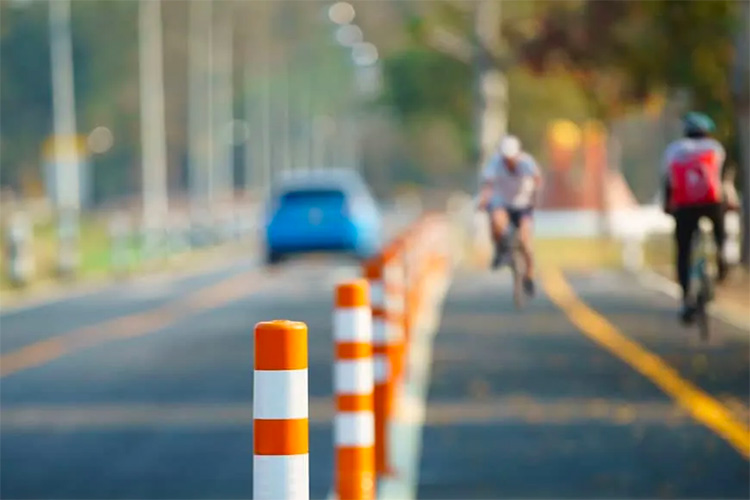Flexible Bollards vs. Traffic Delineators: which traffic safety equipment will provide best value for your application?
May 17, 2021

Flex-post bollards are useful on medians, in parking lots, and to mark bike lanes.
Bollards—the short posts that mark perimeters and guide traffic—are often made of steel or concrete, designed to stop a car in its tracks. Yet in some places, site planners don’t want a fixed bollard that could do vehicle damage or stop a car. Emergency vehicles may need to access a curb, even across a bike lane. Drivers often bump parking stops while trying to get fully into a space, and a hard bollard may cause unnecessary damage. In parking lots, having a lane marker may be necessary to separate traffic lanes—but frustrate wide-turning trucks. In these situations, a flexible solution is needed.
There have been two major approaches to designing flexible markers. In Europe, flexible bollards, based on regular traffic bollards, have become the norm. In North America, flexibility often comes from traffic-safety equipment, like channelizers and delineators. What is the difference between these approaches?
What is a delineator?
To delineate is to mark the position of a border or boundary: a “delineator” is something that indicates that boundary. In North America, the term almost always means a plastic post, wrapped with reflective tape, used to mark a traffic lane. These road markers are also sometimes called flexible channelizers. Portable delineators or channelizers are used to flag road work sites.
These traffic delineators are often used as permanent posts in parking lots. They guide drivers, but when hit, do not damage the vehicle. Later, they became popular as bike lane markers or as markers in a median. Beside bike lanes, these little posts have become critical infrastructure.

Bike lane bollards prevent cars from using the bike lane for parking.
The importance of bike lane bollards
A painted lane on the side of the road is often not enough to encourage cycling. Population-wide studies show that physically-protected bike lanes are a big incentive to non-expert cyclists. Separated bike lanes encourage riders of all ages and abilities. Also, with only paint as a guide, bike lanes often become parking spaces.
Yet in some places, barriers and planters are a no-go, because emergency vehicles or garbage trucks need access to the sidewalk.
North American cities often use flexible traffic delineators as a bike lane separator. Made of inexpensive polyethylene, these slender posts do a very good job in low-traffic areas. Although they may be side-swiped, very few drivers will choose to drive over them to park their cars.
Polyethylene channelizers are sometimes overwhelmed in the harder conditions of a busy road. They can be destroyed if city vehicles run them over more than a few times.
Europe often installs larger, beefier polyurethane flexible bollards that have the look and feel of steel bollards. These tough flex posts are more expensive than the small polyethylene posts. They are also often hardier in high traffic conditions and narrow lanes. They can be driven over when necessary, especially by larger vehicles, but their solid dense profile deters cars from hitting them.
@reliancefoundry #reliancefoundry #bollards
Company:  Reliance Foundry Co. Ltd.
Reliance Foundry Co. Ltd.
Product: Bollards > Flexible
Source: https://www.reliance-foundry.com/blog/flexible-bollards-vs-traffic-delineators
Tags:
Bollards
Channelizers and Flexible Bollards (May 7, 2021), A Complete Guide to Attractive Security Perimeters (March 15, 2021), Bollards for Campus Safety: A strategy for successful traffic management (February 17, 2021), Decorative Concrete: From Buildings to Bollards - Whether Béton brut, smooth and polished, or glossy aggregate, concrete can be beautiful (December 11, 2020)

